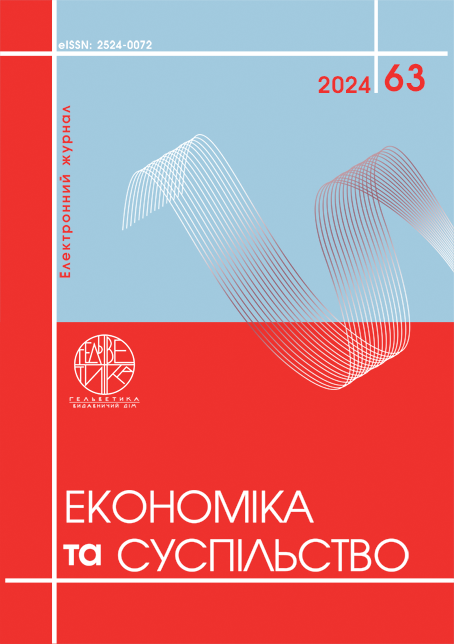PRIORITIES FOR THE DEVELOPMENT OF STATE TAX MANAGEMENT
Abstract
The article is devoted to tax management issues. The article aims to define and substantiate the priorities of tax management development, considering the main global trends and trends in taxation. The authors carried out an analysis of the tax revenues (with social contributions) ratio to GDP over 2014–2023 in EU member-states and Ukraine. It was determined that Ukraine has a moderate tax burden compared to European countries. Only Slovakia, Estonia, Latvia, Malta, Lithuania, Bulgaria, Romania, and Ireland have a lower level of taxation. Currently, measures are being implemented to raise excise tax rates to the minimum level, which set in the EU. Modern trends in tax administration development in developed countries are the digitalization of tax administration processes and fees, the development of tax control tools, and enhancing the institutional capacity of taxation by combating tax fraud and tax evasion. Digitalization of tax administration procedures makes it possible to reduce the time that taxpayers spend filling out tax returns and paying taxes. The expediency of increasing the effectiveness of the tax risk management system is substantiated. Identifying tax risks is the initial stage of their management, which requires using two universal approaches: bottom-up or top-down. Ranking risks according to the probability of their occurrence and their impact on the fiscal effects will help to determine and create a balanced approach to overcoming the spectrum of tax risks. Modern software products are actively used by tax services to identify tax bases. Nowadays, fiscal authorities often use specialized software for maintaining taxpayer registers and systematizing their ranking. It is relevant and important to carry out analytical procedures on big data sets during the processing and in-depth study of tax reporting. It is expedient to simplify procedures for fulfilling tax obligations, improve the quality of services provided by fiscal authorities, expand the communication channels between authorities and taxpayers, and reduce time spent on filling out tax returns and paying taxes while ensuring higher efficiency of state tax control.
References
Бечко П. К., Бечко В. П., Лиса,Н. В., Пташник С. А. Податковий менеджмент у системі податкового адміністрування. Економіка та держава. 2021. № 11. С. 79–83.
Косова Т.Д., Ползікова Г.В., Захарченко Н.В. Механізми податкового менеджменту в умовах антикризової фінансової політики: монографія / Придніпровська державна академія будівництва та архітектури. Дніпро: ПДАБА, 2020. 224 с.
Коваль Н. І. Податковий менеджмент в умовах сучасних реалій: теоретичні та правові основи. Ефективна економіка. 2023. № 3. DOI: http://doi.org/10.32702/2307-2105.2023.3.23
Сідельникова Л. Теоретико-організаційні домінанти податкового адміністрування в системі державного податкового менеджменту. Економіка та суспільство. 2020. Вип. 22. DOI: https://doi.org/10.32782/2524-0072/2020-22-59
Lipniewicz R. Tax administration and risk management in the digital age. Information Systems in Management. 2017. Vol. 6. № 1. P. 26−37.
Au L. T. N., Hoang H. T., Ho L. T. H. Tax service quality for enterprises: development of a valid measurement scale. Asia-Pacific Journal of Business Administration. 2023. Vol 15. № 3. P. 345–360.
Keen M., Slemrod, J. Optimal tax administration. Journal of Public Economics. 2017. Vol. 152. P. 133–142.
Національна стратегія доходів до 2030 року. URL: https://mof.gov.ua/storage/files/National%20Revenue%20Strategy_2030_.pdf (дата звернення: 06.06.2024).
Pasichnyi М. Fiscal dominants of military financing. Scientia fructuosa. 2024. Vol. 154. № 2. P. 20–37.
Tax Administration 3.0: The Digital Transformation of Tax Administration. URL: https://www.skatteetaten.no/globalassets/omskatteet aten/analyse-ograpporter/rapporter/taxadministration-3.0---oecd2020.pdf. (дата звернення: 09.06.2024).
Лекарь С. І. Горизонтальний моніторинг як прогресивний механізм податкового контролю. Економічний форум. 2017. Вип. 2. C. 311–317.
Kaneva T., Chugunov I., Pasichnyi M., Nikitishin A., Husarevych, N. Tax Policy for Economic Recovery and Sustainable Development After COVID-19. PROBLEMY EKOROZWOJU. 2022. vol. 17. № 2. P. 102–109.
Bechko P. K., Bechko V. P., Lysa, N. V., Ptashnyk S. A. (2021) Podatkovyi menedzhment u systemi podatkovoho administruvannia [Tax management in the tax administration system]. Ekonomika ta derzhava – Economy and the state, vol. 11. pp. 79–83.
Kosova T.D., Polzikova G.V., Zakharchenko N.V. (2020) Mekhanizmy podatkovoho menedzhmentu v umovakh antykryzovoi finansovoi polityky [Mechanisms of tax management in the conditions of anti-crisis financial policy: monograph]. Dnipro: Prydniprovska derzhavna akademiia budivnytstva ta arkhitektury. 224 p. [in Ukrainian]
Koval N. I. (2023) Podatkovyi menedzhment v umovakh suchasnykh realii: teoretychni ta pravovi osnovy [Tax management in the conditions of modern realities: theoretical and legal foundations]. Efektyvna ekonomika – Efficient economy, vol. 3. DOI: http://doi.org/10.32702/2307-2105.2023.3.23
Sidelnikova L. (2020) Teoretyko-orhanizatsiini dominanty podatkovoho administruvannia v systemi derzhavnoho podatkovoho menedzhmentu [Theoretical and organizational dominants of tax administration in the system of state tax management]. Ekonomika ta suspilstvo – Economy and society, vol 22. DOI: https://doi.org/10.32782/2524-0072/2020-22-59
Lipniewicz R. (2017) Tax administration and risk management in the digital age. Information Systems in Management, vol. 6 (1), pp. 26−37.
Au L. T. N., Hoang H. T., Ho L. T. H. (2023) Tax service quality for enterprises: development of a valid measurement scale. Asia-Pacific Journal of Business Administration, vol 15 (3), pp. 345–360.
Keen M., Slemrod, J. (2017) Optimal tax administration. Journal of Public Economics, vol. 152, pp. 133–142.
Natsionalna stratehiia dokhodiv do 2030 roku [The National Economic Strategy until 2030 (NES-2030)]. URL: https://mof.gov.ua/storage/files/National%20Revenu-e%-20Strategy_2030_.pdf (accessed June 6, 2024). (in Ukrainian)
Pasichnyi М. (2024). Fiscal dominants of military financing. Scientia fructuosa, vol. 154 (2), pp. 20–37.
Tax Administration 3.0: The Digital Transformation of Tax Administration. URL: https://www.skatteetaten.no/globalassets/omskatteetaten/analyse-ograpporter/rapporter/taxadministration-3.0---oecd2020.pdf. (accessed June 9, 2024).
Lekar S. I. (2017) Horyzontalnyi monitorynh yak prohresyvnyi mekhanizm podatkovoho kontroliu [Horizontal monitoring as a progressive mechanism of tax control]. Ekonomichnyi forum – Economic Forum, vol. 2, pp. 311–317.
Kaneva, T., Chugunov, I., Pasichnyi, M., Nikitishin A., & Husarevych, N. (2022) Tax Policy for Economic Recovery and Sustainable Development After COVID-19. PROBLEMY EKOROZWOJU, vol. 17(2), pp. 102–109.

This work is licensed under a Creative Commons Attribution 4.0 International License.


